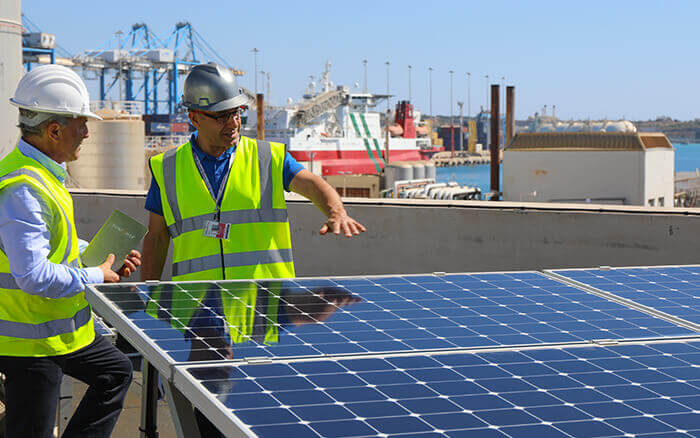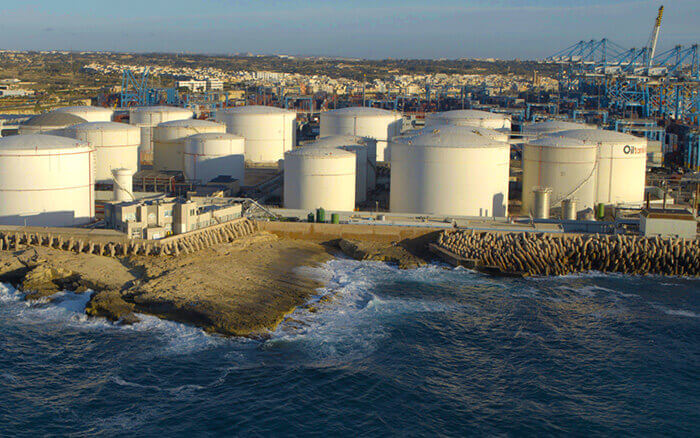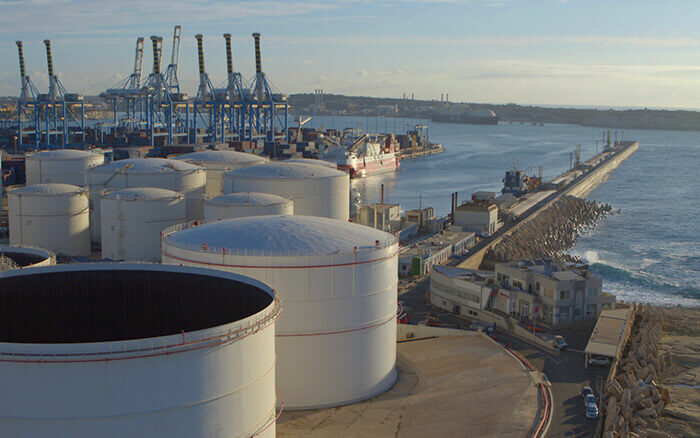
Malta Part 3: International Tanking Company Turns to Solar For Coastal Energy Resilience
Along the coast of Malta, wind speeds can reach record levels, topping 133 kilometers per hour in a 2019 storm. Located at the centre of the Mediterranean Sea, Malta is a strategic shipping point, connecting markets in Europe, North Africa and the Middle East. With so much commerce passing through Malta, the safety and security of its ports are crucial.
“Malta is a tiny island in the Mediterranean,” says David Muscat, deputy technical manager for Oiltanking Malta Ltd. “However, due to our strategic location, we load and discharge cargo to and from many countries across the globe.”
Ships may berth at any of four jetties loading and unloading to and from the storage tanks on the terminal. Products are also transferred from one tank to another with the help of specially designed pumps.

Oiltanking Malta Ltd. Deputy Technical Manager David Muscat reviews a SunPower® Maxeon® solar array with Mario Cachia, CEO of Alternative Technologies Ltd.
All of this product requires resilient tanking facilities. And massive amounts of power.
Marquard & Bahls AG, based in Hamburg, Germany, is one of the largest independent operators of tank terminals worldwide. The company owns and operates 73 terminals in 24 countries across five continents, including its Maltese subsidiary, Oiltanking Malta Ltd.
The main products stored in Malta are chemicals, gases and fuels used in air transport. But when it sought to increase its energy resilience on Malta, the company turned to solar.
“Renewable energy and sustainability are important because the approach towards the environment taken by our mother company has always been to conduct activities in an ecologically responsible matter,” explains David Muscat, Deputy Technical Manager, Oiltanking Ltd.
SunPower Authorised Partner Alternative Technologies Ltd. installed a solar PV system on the roof of three substations and an administrative building. In total, 368 SunPower® Maxeon®3 panels were installed – with the power to generate an estimated 192,000 kWh of clean energy per year. This amount of power reduces carbon dioxide emissions equivalent to 332,000 passenger vehicles per year.1 Source: epa.gov CO2 equivalencies calculator.
Power density is the best-known advantage of SunPower Maxeon panels - as the highest efficiency panels available,2 Based on datasheet review of websites of top 20 manufacturers per IHS, as of May, 2019. they generate 35% more energy from same space over the first 25 years.3 SunPower 400 W, 22.6% efficient, compared to a Conventional Panel on same-sized arrays (310 W mono PERC, 19% efficient, approx. 1.64 m²) They are also ranked #1 in durability.4 Jordan, et. al. Robust PV Degradation Methodology and Application. PVSC 2018
“Maxeon cell technology is durable because of its solid copper foundation, but it is also the most efficient solar in the industry. This allows our customers to save more money with their limited roof space, even in tough environments,” explains Mario Cachia, CEO of Alternative Technologies Ltd.
Braving the Elements: Salt, Wind and Shade
Malta’s shipping terminal is built to the highest international engineering and safety standards. So when a global leader like Marquard & Bahls evaluated solar for the site, they sought a solution with the highest level of reliability.
“Solar energy is a long-term investment and we needed a solution that even under these harsh conditions could withstand the test of time,” David adds. “We did our research and made the choice of selecting SunPower.”
In coastal communities, salt spray is not just an idyllic visual in tourism photos, it’s a very harsh reality.
“The sea itself is a problem because of the salinity it creates in the atmosphere,” Mario explains. “Being so close to the sea we needed to make sure that the panel selected would be able to withstand the harsh saline conditions.”
Salt spray can corrode some solar panels, compromising production over time. But SunPower panels have proven to resist corrosion through the patented tin-plated metal foundation on its Maxeon cell, which is unique in the solar industry. SunPower’s specially-engineered, proprietary encapsulant also provides excellent resistance against moisture or voltage stresses like PID (Potential Induced Degradation), which has been shown to be accelerated by saline moisture.5 https://www.nrel.gov/pv/assets/pdfs/2014_pvmrw_68_tanahashi.pdf, Suzuki, et al., Acceleration of Potential-Induced Degradation y Salt-Mist Preconditioning in Crystalline Silicon Photovoltaic Modules, Japanese Journal of Applied Physics, July 2015.
Standing behind these product advantages, SunPower’s industry-leading 25-year Complete Confidence Warranty covers ocean spray and salt air in coastal regions. Many conventional solar panel manufacturers have warranty exceptions for coastal regions.

The 128kWp SunPower system on several buildings of Oiltanking Malta Ltd. is surrounded by high coastal winds, salt spray and intermittent shadows that would create serious technical challenges for conventional panels.
High winds are another constant factor at any sea port, and Malta is no exception.
The SunPower panels installed at the Oiltanking facility were certified to Cyclonic Load Resistance of over 6400 Pa,6 AS/NZS4040.2 and AS/NZS1170.2 per HSEC report E160520 and ACE report 19-0381.02. equivalent to 375 kilometres per hour,7 https://www.eurocodeapplied.com/ assumes 30m elevation and open terrain. which is above a Category Five on the cyclone intensity scale.8 https://en.wikipedia.org/wiki/Tropical_cyclone_scales
Customers should note that solar systems in high wind areas must be carefully designed by local experts and correctly installed in compliance with local guidelines, regulations and carefully chosen equipment. However, industry experts recommend starting your system design with a high wind-load solar panel as a critical first step.9 https://rmi.org/solar-under-storm-designing-hurricane-resilient-pv-systems/
This is a very relevant consideration in the face of historic weather conditions in the Maltese Islands. In February 2019, Malta was hit with a storm that reportedly was the worst since 1982, with wind gusts reaching a record of 133 kilometers per hour.10 Source: Worst Storm Since 1982’ Saw Record Gusts of 133km/h – Muscat, Times Malta, Feb. 2019. The SunPower solar withstood the battering conditions of worst storm in 50 years, and stands prepared for future extreme weather.
High winds and waves surround the Oiltanking facility and SunPower solar system in early 2019.
While ocean winds and constant salt spray would be challenge enough for most solar panels, the system in Malta’s terminal also faced another challenge: intermittent shading from the surrounding structures that tower above the administration building.
While intermittent shading is not recommended as an ideal condition for solar, in the real-world shadows from fallen leaves or roof obstructions are a reality. Fortunately for the team in Malta, SunPower Maxeon cells have built-in shade protection, so partial shading has much less impact. In fact, Maxeon 3 panels have demonstrated 30% more energy production under partially shaded conditions.11 PV Evolution Labs "SunPower Shading Study," 2013. Compared to a conventional front contact panel.
SunPower Maxeon cells have a unique architecture which manages shading differently than conventional cells. When shaded, they generate 90% less heat, and spread the heat uniformly across the cell,12 Campeau, Z. et al. "SunPower Panel Degradation Rate," SunPower white paper, 2013 so the temperature stays lower – a key factor in optimizing performance and mitigating hotspots.
In the end, the team at Oiltanking Malta was extremely satisfied with their first foray into solar.
“We are actually producing much more [energy] than we expected. We are already in final discussions to add 30% to the present system installed,” David noted. “Oiltanking is really happy with the solar system provided by Alternative Technologies.”
As is Mario Cachia, the project’s installer: “We are very happy to say that the system installed at Oiltanking facilities not only reached the expectations of energy production but it also exceeded the predictions considering the harsh conditions and the shadowing all around,” Mario concludes.
As Malta races toward meeting its EU targets for renewable energy, Oiltanking’s solar installation is a visual reminder that a global energy transition is on its way.
Project SummaryProduct: 368 Maxeon® 3 Solar Panels Project Type: Coastal Commercial Building Rooftop System Size: 120kWp, 185 MWh Annually |
||||||||||||||||||||
| Challenge | Solution | |||||||||||||||||||
Limited roof space |
|
|||||||||||||||||||
|
Harsh Environment: High Temperatures Salinity
Strong Winds |
|
|||||||||||||||||||
Intermittent Shade |
|
|||||||||||||||||||
